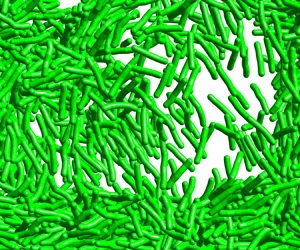Crossref Citations
This article has been cited by the following publications. This list is generated based on data provided by
Crossref.
Markauskas, Darius
Platzk, Stefan
and
Kruggel-Emden, Harald
2022.
Comparative numerical study of pneumatic conveying of flexible elongated particles through a pipe bend by DEM-CFD.
Powder Technology,
Vol. 399,
Issue. ,
p.
117170.
Zhang, Runhui
Ku, Xiaoke
and
Lin, Jianzhong
2022.
Fluidization of the spherocylindrical particles: Comparison of multi-sphere and bond-sphere models.
Chemical Engineering Science,
Vol. 253,
Issue. ,
p.
117540.
Ma, Huaqing
Zhou, Lianyong
Liu, Zihan
Chen, Mengyao
Xia, Xiuhao
and
Zhao, Yongzhi
2022.
A review of recent development for the CFD-DEM investigations of non-spherical particles.
Powder Technology,
Vol. 412,
Issue. ,
p.
117972.
Ren, Wan-Long
Zhang, Yan
Zhang, Xu-Hui
and
Lu, Xiao-Bing
2022.
Investigation of the characteristics and mechanisms of the layer inversion in binary liquid–solid fluidized beds with coarse particles.
Physics of Fluids,
Vol. 34,
Issue. 10,
Zhu, Chenlin
Qian, Lijuan
Lin, Zhaowu
and
Yu, Zhaosheng
2022.
Turbulent channel flow of a binary mixture of neutrally buoyant ellipsoidal particles.
Physics of Fluids,
Vol. 34,
Issue. 5,
Zhou, Lianyong
Ma, Huaqing
Liu, Zihan
and
Zhao, Yongzhi
2022.
Development and verification of coarse‐grain CFD‐DEM for nonspherical particles in a gas–solid fluidized bed.
AIChE Journal,
Vol. 68,
Issue. 11,
Zhang, Hao
Qiao, Wanbing
An, Xizhong
Ye, Xinglian
and
Chen, Jiang
2022.
CFD-DEM study on fluidization characteristics of gas-solid fluidized bed reactor containing ternary mixture.
Powder Technology,
Vol. 401,
Issue. ,
p.
117354.
Yang, Jiecheng
Buettner, Kevin E.
DiNenna, Virginia L.
and
Curtis, Jennifer S.
2022.
Computational and experimental study of the combined effects of particle aspect ratio and effective diameter on flow behavior.
Chemical Engineering Science,
Vol. 255,
Issue. ,
p.
117621.
Zhong, Lixiang
Xu, Dandan
Jiang, Yiyang
and
Guo, Yu
2022.
A numerical study on gas-fluidized beds of wet flexible fibers.
Powder Technology,
Vol. 399,
Issue. ,
p.
117094.
Xu, Dandan
Wang, Bo
Yu, Zhaosheng
and
Guo, Yu
2023.
Clustering in gas‐fluidized riser flows of flexible fibers.
AIChE Journal,
Vol. 69,
Issue. 4,
Pei, Zeguang
and
Xi, Chuanzhi
2023.
Simulation of the dynamics of a flexible fiber in the swirling airflow in a nozzle containing cylindrical and divergent conical sections.
Textile Research Journal,
Vol. 93,
Issue. 13-14,
p.
3308.
Zhang, Chuanpeng
Zhu, Renshuai
Chen, Yanpei
Wang, Wei
and
Furuhata, Tomohiko
2023.
Configuration-dependent dynamics of non-spherical particles in a gas–solid fluidized bed.
Chemical Engineering Journal,
Vol. 465,
Issue. ,
p.
142969.
Coppin, Nathan
Henry, Michel
Cabrera, Miguel
Azéma, Emilien
Dubois, Frédéric
Legat, Vincent
and
Lambrechts, Jonathan
2023.
Collapse dynamics of two-dimensional dry and immersed granular columns of elongated grains.
Physical Review Fluids,
Vol. 8,
Issue. 9,
Han, Jiawei
Shen, Kai
Guo, Yu
Xiong, Hongbing
and
Lin, Jianzhong
2023.
Discrete element simulations of flexible ribbon-like particles.
Powder Technology,
Vol. 429,
Issue. ,
p.
118950.
Zhou, Wen
Miwa, Shuichiro
and
Okamoto, Koji
2024.
Advancing fluid dynamics simulations: A comprehensive approach to optimizing physics-informed neural networks.
Physics of Fluids,
Vol. 36,
Issue. 1,
Huang, Duoduo
Zhang, Erqiang
Ding, Meizhou
Wang, Le
Li, Hui
Pan, Fanda
Zhang, Hongzhao
and
Zhu, Wenkui
2024.
3D Flexible Ribbon Chain Model for Simulating Dynamic Behaviors of Flexible Ribbon Particles in a Pneumatic Conveying Dryer.
Industrial & Engineering Chemistry Research,
Vol. 63,
Issue. 14,
p.
6374.
Wang, Siyuan
Shen, Kai
Xiong, Hongbing
Lin, Jianzhong
and
Guo, Yu
2024.
A numerical investigation on segregation in gas-fluidized beds of short, flexible fibers.
Advanced Powder Technology,
Vol. 35,
Issue. 1,
p.
104304.






